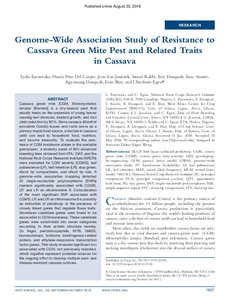| dc.contributor.author | Ezenwaka, L. |
| dc.contributor.author | Carpio, D.P. del |
| dc.contributor.author | Jannink, Jean-Luc |
| dc.contributor.author | Rabbi, I.Y. |
| dc.contributor.author | Danquah, E.Y. |
| dc.contributor.author | Asante, I. |
| dc.contributor.author | Danquah, A. |
| dc.contributor.author | Blay, E. |
| dc.contributor.author | Egesi, Chiedozie N. |
| dc.date.accessioned | 2019-12-04T11:24:28Z |
| dc.date.available | 2019-12-04T11:24:28Z |
| dc.date.issued | 2018-08 |
| dc.identifier.citation | Ezenwaka, L., Del Carpio D.P., Jannink, J.L., Rabbi, I.Y., Danquah, E., Asante, I., ... & Egesi, C. (2018). Genome-wide association study of resistance to cassava green mite pest and related traits in cassava. Crop Science, 58(5), 1907-1918. |
| dc.identifier.issn | 0011-183X |
| dc.identifier.uri | https://hdl.handle.net/20.500.12478/4378 |
| dc.description | Published: 26 July 2018 |
| dc.description.abstract | Cassava green mite [CGM, Mononychellus tanajoa (Bondar)] is a dry-season pest that usually feeds on the underside of young leaves causing leaf chlorosis, stunted growth, and root yield reduction by 80%. Since cassava (Manihot esculenta Crantz) leaves and roots serve as a primary staple food source, a decline in cassava yield can lead to household food, nutrition, and income insecurity. To evaluate the existence of CGM resistance alleles in the available germplasm, a diversity panel of 845 advanced breeding lines obtained from IITA, CIAT, and the National Root Crops Research Institute (NRCRI) were evaluated for CGM severity (CGMS), leaf pubescence (LP), leaf retention (LR), stay green, shoot tip compactness, and shoot tip size. A genome-wide association mapping detected 35 single-nucleotide polymorphisms (SNPs) markers significantly associated with CGMS, LP, and LR on chromosome 8. Colocalization of the most significant SNP associated with CGMS, LP, and LR on chromosome 8 is possibly an indication of pleiotropy or the presence of closely linked genes that regulate these traits. Seventeen candidate genes were found to be associated to CGM resistance. These candidate genes were subdivided into seven categories according to their protein structure namely, Zn finger, pentatricopeptide, MYB, MADS, homeodomain, trichome birefringence-related protein, and ethylene-responsive transcription factor genes. This study revealed significant loci associated with CGM, not previously reported, which together represent potential sources for the ongoing effort to develop multiple pest- and disease-resistant cassava cultivars. |
| dc.description.sponsorship | Bill & Melinda Gates Foundation |
| dc.format.extent | 1907-1918 |
| dc.language.iso | en |
| dc.subject | Cassava |
| dc.subject | Mononychellus Tanajoa |
| dc.subject | Fertilizers |
| dc.subject | Planting |
| dc.title | Genome-wide association study of resistance to cassava green mite pest and related traits in cassava |
| dc.type | Journal Article |
| dc.description.version | Peer Review |
| cg.contributor.crp | Roots, Tubers and Bananas |
| cg.contributor.affiliation | National Root Crops Research Institute, Nigeria |
| cg.contributor.affiliation | Cornell University |
| cg.contributor.affiliation | International Institute of Tropical Agriculture |
| cg.contributor.affiliation | University of Ghana |
| cg.coverage.region | Africa |
| cg.coverage.region | West Africa |
| cg.coverage.country | Nigeria |
| cg.creator.identifier | Ismail Rabbi: 0000-0001-9966-2941 |
| cg.creator.identifier | Chiedozie Egesi: 0000-0002-9063-2727 |
| cg.researchtheme | BIOTECH & PLANT BREEDING |
| cg.isijournal | ISI Journal |
| cg.authorship.types | CGIAR and developing country institute |
| cg.iitasubject | Plant Breeding |
| cg.journal | Crop Science |
| cg.howpublished | Formally Published |
| cg.accessibilitystatus | Open Access |
| local.dspaceid | 100553 |
| cg.targetaudience | Scientists |
| cg.identifier.doi | https://dx.doi.org/10.2135/cropsci2018.01.0024 |

